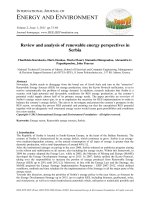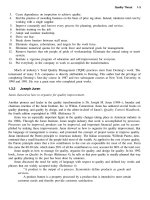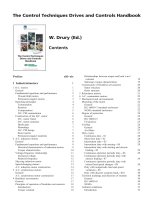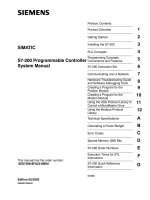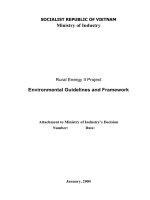environmental instrumentation and analysis handbook
Bạn đang xem bản rút gọn của tài liệu. Xem và tải ngay bản đầy đủ của tài liệu tại đây (12.73 MB, 1,080 trang )
ENVIRONMENTAL
INSTRUMENTATION AND
ANALYSIS HANDBOOK
RANDY D. DOWN
Forensic Analysis & Engineering Corp.
JAY H. LEHR
The Heartland Institute
Bennett and Williams, Inc.
A JOHN WILEY & SONS, INC., PUBLICATION
ENVIRONMENTAL
INSTRUMENTATION AND
ANALYSIS HANDBOOK
ENVIRONMENTAL
INSTRUMENTATION AND
ANALYSIS HANDBOOK
RANDY D. DOWN
Forensic Analysis & Engineering Corp.
JAY H. LEHR
The Heartland Institute
Bennett and Williams, Inc.
A JOHN WILEY & SONS, INC., PUBLICATION
Copyright # 2005 by John Wiley & Sons, Inc. All rights reserved.
Published by John Wiley & Sons, Inc., Hoboken, New Jersey.
Published simultaneously in Canada.
No part of this publication may be reproduced, stored in a retrieval system, or transmitted in any form or
by any means, electronic, mechanical, photocopying, recording, scanning, or otherwise, except as
permitted under Section 107 or 108 of the 1976 United States Copyright Act, without either the prior
written permission of the Publisher, or authorization through payment of the appropriate per-copy fee
to the Copyright Clearance Center, Inc., 222 Rosewood Drive, Danvers, MA 01923, 978-750-8400,
fax 978-750-4470, or on the web at www.copyright.com. Requests to the Publisher for permission should
be addressed to the Permissions Department, John Wiley & Sons, Inc., 111 River Street, Hoboken,
NJ 07030, (201) 748-6011, fax (201) 748-6008.
Limit of Liability/Disclaimer of Warranty: While the publisher and author have used their best efforts in
preparing this book, they make no representations or warranties with respect to the accuracy or
completeness of the contents of this book and specifically disclaim any implied warranties of
merchantability or fitness for a particular purpose. No warranty may be created or extended by sales
representatives or written sales materials. The advice and strategies contained herein may not be suitable
for your situation. You should consult with a professional where appropriate. Neither the publisher nor
author shall be liable for any loss of profit or any other commercial damages, including but not limited to
special, incidental, consequential, or other damages.
For general information on our other products and services please contact our Customer Care Department
within the U.S. at 877-762-2974, outside the U.S. at 317-572-3993 or fax 317-572-4002.
Wiley also publishes its books in a variety of electronic formats. Some content that appears in print,
however, may not be available in electronic format.
Library of Congress Cataloging-in-Publication Data:
Down, Randy D.
Environmental instrumentation and analysis handbook / Randy D. Down, Jay H. Lehr.
p. cm.
Includes index.
ISBN 0-471-46354-X
1. Environmental monitoring–Instruments–Handbooks, manuals, etc.
2. Pollution–Measurement–Handbooks, manuals, etc. I. Lehr, Jay H., 1936- II. Title.
TD193.D685 2004
628–dc22 2004005656
Printed in the United States of America
10987654321
CONTENTS
Preface ix
PART I INSTRUMENTATION METHODOLOGIES
1 Influence of Regulatory Requirements on
Instrumentation Design 3
Randy D. Down
2 In Situ Versus Extractive Measurement Techniques 13
Gerald McGowan
3 Validation of Continuous Emission Monitor (CEM) System
Accuracy and Reliability 49
Todd B. Colin
4 Integration of CEM into Distributed Control Systems 61
Joseph A. Ice
5 Infrared Absorption Spectroscopy 87
Tye Ed Barber, Norma L. Ayala, John M.E. Storey, G. Louis Powell,
William D. Brosey, and Norman R. Smyrl
6 Ultraviolet Analyzers 119
Jeffrey E. Johnston and Marc M. Baum
7 Total Hydrocarbon Analysis Using Flame
Ionization Detector 147
John Kosch
v
8 Gas Chromatography in Environment al Analysis 157
John N. Driscoll
9 Online Analysis of Environmental
Samples by Mass Spectrometry 187
Raimo A. Ketola
10 Photo ionization 221
John N. Driscoll
11 Portable Versus Stationary Analytical Instruments 237
Randy D. Down
12 Applicat ion of XRF to the Analysis of
Environmental Samples 251
John N. Driscoll
13 Laboratory Analysis 271
Paul J. Giammatteo and John C. Edwards
14 Solid-Phase Microextraction 295
Yong Chen and Janusz Pawliszyn
15 Continuous Particulate Monitoring 329
William J. Averdieck
16 Gas Survey Instruments 355
Randy D. Down
17 Ion Chromatography for the Analysis of
Inorganic Anions in Water 371
Peter E. Jackson
18 Ultraviolet–Visible Analysis of Water and Wastewater 401
Bernard J. Beemster
PART II WATER QUALITY PARAMETERS
19 Thermal Conductivity Detectors 419
John M. Hiller and Nancy M. Baldwin
20 Opacity Monitors 433
Julian Saltz
vi
CONTENTS
21 Temperature Measurement 445
Randy D. Down
22 pH Analyzers and Their Application 459
James R. Gray
23 Conductivity Analyzers and Their Application 491
James R. Gray
24 Turbidity Monitoring 511
John Downing
25 Watershed Scale, Water Quality Monitoring–Water Sample
Collection 547
Randy A. Dahlgren, Kenneth W. Tate, and Dylan S. Ahearn
PART III GROUND WATER MONITORING
26 Level Measurements in Groundwater Monitoring Wells 567
Willis Weight
27 Laboratory Analysis of Wastewater and
Groundwater Samples 593
Lawrence R. Keefe
28 Techniques for Groundwater Sampling 605
Robert M. Powell
29 Soil Permeability and Dispersion Analysis 625
Aziz Amoozegar
30 Passive Sampling 679
Lee Trotta
31 Instrumentation in Groundwater Monitoring 687
David L. Russell
32 Microb iological Field Sampling and Instrumentat ion in
Assessment of Soil and Groundwater Pollution 701
Ann Azadpour-Keeley
CONTENTS vii
PART IV WASTEWATER MONITORING
33 Use of Instrumentation for pH Control 733
Mark Lang
34 Automatic Wastewater Sampling Systems 741
Bob Davis and Jim McCrone
35 Optimum Wastewater Sampling Locations 769
Bob Davis and James McCrone
36 Wastew ater Level Measurement Techniques 791
Ernest Higginson
PART V AIR MONITORING
37 Data Acquisition Systems for Ambient Air Monitoring 817
Matthew Eisentraut and Martin Hansen
38 Air Pollution Control Systems 847
Randy D. Down
39 Measu rement of Ambient Air Quality 863
Gerald McGowan
PART VI FLOW MONITORING
40 Air Flow Measurement 897
Randy D. Down
41 Gas Flow Measurement 911
Ashok Kumar, Jampana Siva Sailaja and Harish G. Rao
42 Non-Open-Channel Flow Measurement 945
Randy D. Down
43 Open-Channel Wastewater Flow Measurement Techniques 959
Bob Davis and Jim McCrone
44 Compliance Flow Monitoring in Large Stacks and Ducts 993
Richard Myers
Index 1015
viii CONTENTS
PREFACE
It has been two decades sinc e environmental science, environmental engineering,
and environmental consulting took root as major disciplines and professions
throughout the developed world. The learning curve has been steep as it relates
to the previously unrecognized physics of contaminant transport. Today those
principles are usually well understood by a mature army of environmental
professions.
An area that has lagged in full comprehension among the practitioners in these
fields is an understanding and awareness of the hardware for measuring the physical
and chemical characteristics of contaminated sites. The application of these
instruments and methodologies to characterize the solid, liquid, and gaseous
chemical content within a transport media are not well understood.
Professionals have long relied on personal experience, diverse journal articles,
and manufacturer’s advertisements and catalogs to choose efficient and accurate
means of obtaining the necessary field data to characterize a site. This has resulted
in too narrow a focus in the development of appropriate remediation programs and
monitoring protocols.
More than three dozen talented environmental professionals who are experi-
enced and adept at extracting the most telling and accurate data from the ‘‘field’’
have come together in this book to catalog nearly all the equipment and techniques
that are available to modern scientists, engineers, and technicians.
This has been a fulfilling and rewarding effort: the gathering of the best and
brightest professionals acro ss many continents to share their expertise. We have
asked them to describe the basic science, be it physics, chemistry, biology,
hydrology, or computer data loggi ng, that supports their field analysis followed
by detailed explanations of the various hardware in use today. In most cases the
authors offer descriptions of typical case studies in which the equipment was
successfully utilized.
ix
Of significant value are the pitfalls and foibles of the procedures and equipment
that may not always measure up under less than ideal conditions. What may go
wrong is often as valuable as what should correctly occur.
For ease of access, we have divided the description of field instruments and
procedures into six basic categories: instrumentation and methodologies, water
quality parame ters, groundwater monitoring, wastewater monitoring, air monitor-
ing, and flow monitoring. Some sections could have fit neatly in more than one
category, but we trust the reader will have no trouble identifying the information
being sought regardless of the category in which it is placed.
It is rare to have an opportunity to add a truly innovative package of information
to the literature that has not been previously attempted. We are confident that this
has been achieved through the cooperation and dedication of the many contributors
to this book to whom we are eternally grateful.
We made no strong effort to confine the authors to a special format of
presentation in length, depth, or breadth of their subject matter. We only asked
that they enable the reader to fully understand the conditions under which field
instruments and procedures were appl icable and how to implement their use.
Some authors felt their specialty was in need of a comprehensive detailed expose
not readily found in existing literature. They saw this book as an opportunity to
supply just such a treatise. Other authors felt only a brief ‘‘how-to’’ manual
approach was sufficient in their area of expertise. The reader will recognize these
differences and likely benefit equally from both approaches.
Our profession has needed this handbook for the past decade. We hope it will fill
the need for the next decade.
J
AY H. LEHR
x PREFACE
I
INSTRUMENTATION
METHODOLOGIES
1
INFLUENCE
OF REGULATORY
REQUIREMENTS
ON INSTRUMENTATION
DESIGN
Randy D. Down, P.E.
Forensic Analysis & Engineering Corp.
Raleigh, North Carolina
1.1 Introduction
1.2 Environmental Regulatory Requirements
1.3 Key Factors Influencing Development
1.4 Emerging Sensor Technology
1.5 Other Advancing Technologies
1.6 Regulatory Trends
1.7 MACT/BACT Analysis
1.8 Product Development
1.9 Networked Systems
1.10 Future Considerations
1.11 International Organization for Standardization
1.12 Conclusion
1.13 Additional Sources of Information
Environmental Instrumentation and Analysis Handbook, by Randy D. Down and Jay H. Lehr
ISBN 0-471-46354-X Copyright # 2005 John Wiley & Sons, Inc.
3
1.1 INTRODUCTION
Federal, state, and local regulatory requirements have long played an important role
in driving the advancement of new technologies for the measurement and control of
environmental pollution. They will continue to do so. The same can be said for
competitive advancements in measurement and control technology—that they drive
the regulatory requireme nts. As this chapter will illustrate, regulations and compe-
titive, technological development ultimately work hand in hand to influence the
future of environmental instrumentation—thus the rapidly changing nature of envir-
onmental instrumentation and controls.
This handbook will serve as a valuable guide in the application of new and
emerging environmental instrumentation and control technologies needed to meet
current and future regulatory requirements.
1.2 ENVIRONMENTAL REGULATORY REQUIREMENTS
It was not intended that this handbook serve as a reference for environmental
regulatory requirements. Regulatory requirements vary from s tate to state throughout
the United States and abroad and are periodically updated and revised. Any infor-
mation regarding regulatory requirements that pertains to your geographical loca-
tion should be obtained directly from the appropriate local governing agencies. It is
advisable to work with a local or regional environmental consultant or directly with
the regulatory agency to determine which regulations apply to your specific appli-
cation. Doing so will greatly reduce your risk of misapplying expensive instruments
and potential incurring fines that may be imposed for failing to meet all regulatory
requirements. Such fines can b e very costly and embarrassing.
When involved in the development, specification, or selection and application of
instrumentation, as it relates to environmental applications, this book will serve as a
very useful technical resource. It will aid you in asking the right questions and
avoiding some of the many potential pitfalls that can occur when trying to select
and specify appro priate instrumentation for a measurement or control application.
1.3 KEY FACTORS INFLUENCING DEVELOPMENT
Two key factors drive the development of new technology as it applies to environ-
mental measurement and control:
Steps required to cost effectively meet compliance requirements dictated by
federal and state regulatory agencies
An opportunity to be highly profitable by being the first firm to develop and
market a new, more cost-effective and reliable technology (sensor, transmitter,
analyzer, telemetry device, and/or controlle r). Statistically, those companies
that are first to market with a new technology tend to capture and retain 70%
4 INFLUENCE OF REGULATORY REQUIREMENTS ON INSTRUMENTATION DESIGN
or more of the total market share. Therefore, great emphasis is placed on
being the first firm to market an innovative or more cost-effective, new
product or technology.
New environmental measurement and control technology comes from many
areas of science and industry. Government and private investments made in the
development of new alloys and synthetic materials as well as smaller and lighter
electromechanical components are one example. Sensor technology for the aero-
space and auto industries is a good example of a major source of new technology
and products. Spin-off applications, if applicable to industrial and commercial
applications (and relatively cost effective), can have dramatic results in advancing
control technology. Major aerospace and automobile manufacturers as well as
government agencies often have greater resources with which to fund in-depth
research and development.
1.4 EMERGING SENSOR TECHNOLOGY
Advancement of new sensor technology is by far the most influential factor in the
evolution of regulatory requirements as well as instrumentation and control tech-
nologies. Keeping up with this technology is a major challenge for regulatory
experts, scientists, and engin eers who are tasked with providing clients and the
general public with the optimal means of pollution measurement and abatement.
When establishing the minimum human exposure limit for known and suspected
carcinogens, the regulatory minimum exposure level is often established by the
minimum measurable concentration. The minimum measurement level established
by the government must be achievable in terms of measurment accuracy and repeat-
ability. Unattainable regulatory limits would be meaningless.
The ability of a measurement system to accurately monitor an environmental
variable (such as humidity, temperature, pressure, flow and level) or to detect
and analyze a specific chemical substance and its concentration over time is crucial
if we are to successfully measure and control pollutants and preserve the health and
safety of our environment.
Measurement, as discussed in greater depth later in this book, is a function of
accuracy, precision, reliability, repeatability, sensitivity, and response time. As new
sensor technology evolves, its value to the industry will be judged by its ability to
meet these criteria and by its relative cost in relation to currently used technology.
1.5 OTHER ADVANCING TECHNOLOGIES
Closely fol lowing the rapidly advancing sensor technology and further influencing
sensor development is the continuing development of solid-state electronics and
large-scale integration of electronic circuitry into microcircuitry. Development of
microminiature electronic components (such as resistors , diodes, capacitors,
transistors, and integrated circuits) and ‘‘nano technology’’ (the development of
OTHER ADVANCING TECHNOLOGIES 5
microminiature mechanical/electrical devices) has positively influenced the
measurement and controls industry in multiple ways:
Electronic and mechanical components are now physically much smaller.
Being smaller, these devices require less electrical energy to function.
Using less energy, they also produce less heat, allowing them to be housed in
more compact, better sealed, and in some cases nonventilated enclosures.
Allowing them to be tightly enclosed makes them better suited for use in harsh
environments and means they are less likely to be influenced by variations in
temperature, vibration, and humidity.
manufacturing and assembly costs are significantly reduced.
consumer prices are reduced.
If we look deeper, we find that other technological advances have allowed and
supported the continued development of these microcircuits and components. A
prime example is the advancement of clean-room technology. A dust particle,
spore, strand of human hair, or chafe (particles of dry skin) will appear quite large
under a microscope when examined alongside some modern-day miniaturized com-
ponents and circuitry. Such environmental ‘‘contamination’’ can damage or impair
the reliability and performance of these microminiature components.
Advancements in clean-room design and packaging technology have signifi-
cantly reduced the risk of such contamination. This has largely been accomplished
through the development of high-efficiency air filtration systems and better guide-
lines for proper ‘‘housekeeping,’’ such as
wearing low-particulate-producing disposable suits, booties, and hair nets;
providing pressurized gown-up areas, airlocks, and positively pressurized
clean-room spaces (to prevent contaminated air from migrating into the
cleaner space); and
providing ‘‘sticky’’ mats at entering doorways to pick up any particulate that
might otherwise be ‘‘tracked in’’ on the bottom of footwear.
Conversely, advancements in clean-room technology have largely occurred
through improved accuracy in measuring and quantifying the presence of airborne
contaminants.
Improved accuracy of particulate monitoring instrumentati on is a good example
of advancing sensor technology that is aiding the advancement in measuring and
certifying clean-room quality, which in turn has aided advancements in sensor tech-
nology. This is a good example of different technologies that are ultimately working
hand in hand to accelerate the advancement of environmental instrumentation tech-
nology.
Nanotechnology (the creation of functional materials, devices, and systems
through control of matter on a length scale of 1–100 nm) may very well have the
greatest impact of any technological advancement in measurement and control
6 INFLUENCE OF REGULATORY REQUIREMENTS ON INSTRUMENTATION DESIGN
technology over the next 10–15 years. The manipulation of physical properties
(physical, chemical, biological, mechanical, electrical) occurs at a microminiature
scale. To put it in perspective, 10 nm is approximately a thousand times smaller
than the diameter of a human hair. A scientific and technical revolution is beginning
based on the newfound ability to systematically organize and manipulate matter at
the nanoscale.
1.6 REGULATORY TRENDS
Regulatory agencies tend to avoid direct specification of a technology to meet a
regulatory requirement. They wisely prefer to define performance criteria (accuracy
and reliability) that must be achieved in order to be in regulatory compliance. In so
doing, regulatory agencies can avoid specifying a level of system performance that
exceeds readily available technology. It also reduces the risk of specifying tech-
nologies that are available but are so cost prohibitive that they would create undue
financial hardship for those companies found to be out of compliance.
Regulatory agencies must weigh the potentially high cost of available tech-
nology against the value derived by enforcing a cleaner environment and ultimately
determine what is in the public’s best interest. These decisi ons are often contro-
versial and may be challenged in the courts. At risk are thousands of jobs, as com-
panies are required to spend millions of dollars to significantly reduce their air
emissions (or pretreat wastewater) and remain com petitive with overseas compa-
nies. This burden on manufacturers must be weighed against the potential long-
term (and perhaps yet-unknown) impact of the exposure of people and the environ-
ment to human-generated contaminants.
An effective approach to working with industry to continuously improve our
nation’s air and water quality while not financially crippling U.S. companies (which
in some cases compete with overseas firms facing fewer environmental restrictions)
is to employ a MACT (maximum achievable control technology) or BACT (best
available control technology) analysis and gradually increase restrictions on certain
pollutants over a period of several years.
Graduated environmental restrictions allow several things to occur that aid
industry: They allow industrial firms time to determine and budget for the cost
of compliance, schedule downtime (if necessary), and investigate methods of
changing their internal production processes to lower the level of emitted pollutants
requiring control. They also allow system developers and pollution control system
manufacturers additional time to develop methods to meet compliance require-
ments that are more cost effective than current technology may allow.
1.7 MACT/BACT ANALYSIS
Addressing the issue of abatement costs versus the benefits to the environment
requires a methodology that will establish the best approach based on present-day
MACT/BAC T ANALYSIS 7
technology. Typically, the approach that has been adopted by many state regulatory
agencies is either a BACT or MACT study and report.
In a MACT or BACT analysis, the feasible alternatives for pollution control are
examined and compared in a matrix, weighing factors such as pollutant removal
efficiency, capital costs, operating costs, life expectancy, reliability, and complexity.
Ultimately, a cost per unit volume of pollutant removed, ususally expressed in
dollars per ton, is established for each viable option. The option having the best
projected cost per volume of removed pollutant is usually selected unless there
are extenuating reasons not to (such as a lack of available fuel, insufficient space
for the equipment, or a lack of trained or skilled support staff needed to operate or
maintain the system).
As an example, a BACT or MACT analysis for abatement of pollutant air emis-
sions will often include evaluation of such technologies as carbon recovery system s,
thermal oxidizers, scrubbers, dust collectors, and flares.
Evaluating these various technology options requires a detailed determination of
their cost of construction, operation, maintenance, waste disposal, and salvage.
Typically, an environmental consultant is contracted to perform an independent
BACT or MACT analysis. This helps avoid potential public concerns over a per-
ceived conflict of interest if the analysis were performed in-house.
Pollution abatement system costs often range well into the thousands, in some
cases millions, of dollars. Cost of abatement systems is largely dependent upon:
Type and controllability of substances to be abated
Supplemental fuel costs
Disposal of the removed pollutant (if any)
Quantity (volumetric flow rate) of the pollutant
Some pollutants, such as mercury, are much more difficult to remove than others,
such as volatile organic compounds (VOCs). They may also need to be handled and
disposed of differently (further driving up the total cost of abatement).
As a general rule, the larger the volume of pollutants generated, the physically
larger the equipme nt needed to handl e it, and perhaps the more equipment is needed
to control it. All of these characteristics serve to drive up the cost of abatem ent.
Various pollution abatement systems are described in greater depth later in this
book.
1.8 PRODUCT DEVELOPMENT
As mentioned earlier, many factors influence the development of pollution control
technology and environmental instrumentation. Among the major factors influenc-
ing instrumentation development are:
Increasingly stringent regulatory requirements
Continuing advancements in micro electronics
8 INFLUENCE OF REGULATORY REQUIREMENTS ON INSTRUMENTATION DESIGN
Advancing clean-room technology
Sensor development for the aerospace and automotive industries (‘‘spin-offs’’)
Emerging networking technologies (Internet, Ethernet, Fieldbus, wireless
telemetry)
A globa lly competitive market for instrumentation and controls
Manufacturers of sensors used in environmental control applications and
pollution abatement technologies will continue to develop and market new sensor
technology, with no apparent end in sight. As the technology advances, allowing
more cost-effective measurement of pollutants, more stringent environmental
limits will be imposed until the general public is satisfied that sufficient pollution
control strategies have been established to reverse the concerns over a clean
environment.
1.9 NETWORKED SYSTEMS
The current trend in the instrumentation industry as a whole is to network what are
referred to as ‘‘intelligent’’ transmitters and analyzers that contain their own micro-
processors. Typically, they have a unique device address on a daisy-chained,
twisted/shielded pair of wires. The transmitter or analyzer onboard microprocessor
has the ability to run self-diagnostics and identify hardware problems (e.g., sensor
failure). This ability to diagnose a transmitter or sensor problem from a remote
location (using the workstation PC, a laptop, or a hand-held diagnostic tool) has
particular value when the transmitters are mounted in such difficult-to-access loca-
tions as the top of a high exhaust stack without the use of special equipment.
Smart transmitters are also capable of transmitting output data at a much faster
‘‘digital’’ speed than an analog signal that requires a longer scanning period for a
computer or processor to determine and update its output value. This gives them a
faster system reaction time (or scan time). Typic ally, such networked ‘‘intelligent’’
transmitters are connected to a DCS (distributed control system) by a single net-
work cable (typically a single twisted and shielded pair of wires). In such a system,
the central processor at the front end of the system (also referred to as operator
workstations) communicates over a daisy-chained serial connec tion (twisted pair
of wires) directly with each field device. Large systems can have hundreds of
such field devices. As mentioned earlier, each smart device is assigned a unique
address for identification.
Portable instruments have also advanced a great deal in the last 20 years. This
is largely due to the advancements in microelectronics and batteries. Battery
technology has allowed battery size, weight, and cost to be reduced. This further
enhances the performance of portable instruments, which will be discussed in
much greater depth later in this handbook. Portable instruments offer many advan-
tages as well as some disadvantages when compared to stationary instruments.
NETWORKED SYSTEMS 9
1.10 FUTURE CONSIDERATIONS
Looking into our future (albeit without the aid of a crystal ball), it would seem that
the greatest advances in environmental instrumentation development over the next
10 years will likely center around advanced technology and cost reductions in the
areas of:
Faster data processing
More intelligent field devices
Lower cost analyzers
Microminiature electromechanical applications using nanotechnology
Extensive use of wireless telemetry
Faster sensor response times (greater sensitivity, quicker response to changes
in the measured variable)
An improved ability to detect and measure concentrations of airborne pollutants
and reduced costs for these instruments will likely lead to more stringent clean-air
requirements. An analogy is the introduction and development of elect ric and com-
bination gas-and-electric cars (cleaner fuel-burning transportation), which will con-
tinue to drive clean-air technology as well as slow down the depletion of our finite
supply of fossil fuels.
Another potential change in our near future will be greater efforts by pollution
control system manufacturers to market packaged abatement systems, with instru-
mentation and controls a pretested part of the overall system package.
1.11 INTERNATIONAL ORGANIZATION FOR STANDARDIZATION
With significant advances in science and technology and a greater sharing of
technologies in large part due to the end of the Cold War and creation of a worldwide
web, the engineering community worldwide has grown much closer. It has thus
become apparent that international quality standards are needed in order to provide
a consistent level of quality engineering and management standards worldwide. The
International Organization for Standardization (ISO) develops standards for this
purpose. Its standards are being adopted by many international firms and profes-
sional organizations. These quality standards may someday be adopted by regula-
tory agencies as a minimum level of quality that must be attained. This will
influence the development and quality of instrumentation worldwide in a very posi-
tive way.
An example of these standards, ISO 9001, specifies requirements for a quality
management system for any organization that needs to demonstrate its ability to
consistently provide product that meets customer and applicable regulatory require-
ments and aims to enhance customer satisfaction. Standard ISO 9001:2000 has been
organized in a user-friendly format with terms that are easily recognized by all
10 INFLUENCE OF REGULATORY REQUIREMENTS ON INSTRUMENTATION DESIGN
business sectors. The standard is used for certification/registration and contractual
purposes by organizations seeking recognition of their quality management system.
The greatest value is obtained when the entire family of standards is used in an
integrated manner. This enables companies to relate them to other management sys-
tems (e.g., environmental) and many sector-specific requirements (such as ISO/TS/
16949 in the automotive industry) and will assist in gaining recognition through
national award programs.
1.12 CONCLUSION
Keeping up with technological advancements in environmental instrumentation and
control systems is a daunting task for scientists, engineers, and technicians. There is
no end to this process. Aside from the laws of physics, we can anticipate a conti-
nuation of major technological advances in the years ahead.
The good news is that the cost of the technology will likely continue to decline
while sensitivity and capability of the instruments will continue to rise. Much in the
way that PC technology has evolved in recent years, advancing technologies will
drive capability up and at the same time, through healthy competition, drive costs
down.
Environmental instrumentation will continue to play a vital role in monitoring
and protecting our health and in our very existence. The better we u nderstand
how to correctly apply it, the better our opportunity to understand and manage
the impact on our environment.
1.13 ADDITIONAL SOURCES OF INFORMATION
Information contained in this handbook will aid you in understanding the various
applications and solutions most often encountered in this field. It would not be pos-
sible to provide all of the answers in a single volume.
Supplemental information can be found by reading technical articles in trade
journals and through lectures and conferences conduc ted by organizations such
as the Instrumentation, Systems and Automation Society (ISA), formerly known
as the Instrumen t Society of America.
Equipment suppliers and system houses, although somewhat biased toward their
own supplier’s line of instruments and components (because that is how they
generate the most revenue), are often a good source of information, particularly
regarding availability and cost. They tend to be more knowledgable than consul-
tants about the technical aspects of their specific product lines. They often are
involved with the installation, programming, and servicing of the equipment, not
just the performance and specification aspects, as are many consultants.
Independent engineering consultants offering expertise in environmental and
instrumentation-and-control applications are another good resource. Good con-
sultants offer an advantage (over system houses) of not being biased toward a
ADDITIONAL SOURCES OF INFORMATION 11
particular manufacturer’s equipment. They tend to act more on the client’s behalf
because they do not stand to profit by convincing the client to use a particular man-
ufacturer’s product line. They can also help establish budgetary costs and schedul-
ing requirements for the design, purchase, and installation of the instruments and
controls.
Another source of useful information is the technical library. Most public
libraries are virtually devoid of any helpful or current literature on environmental
instrumentation and controls. University libraries are much more likely to retain the
technical of books and other literature that can be useful.
Helpful guidance in selecting instrumentation for an envrionmental application
can be found on the Internet using one of many very good search engines. The
Internet can be used to find useful information on:
New technological inovations
New product releases
Equipment pricing and specifications
Available literature and catalogs
Consultants
Manufacturers
In conclusi on, seek out the information that y ou will need in order to obtain the
proper instrumentation for your application before making a substantial investment.
In the long run, it will save a great deal of time and help avoid costly and sometimes
embarassing rework.
12 INFLUENCE OF REGULATORY REQUIREMENTS ON INSTRUMENTATION DESIGN
2
IN SITU VERSUS
EXTRACTIVE
MEASUREMENT
TECHNIQUES
Gerald McGowan
Teledyne Monitor Labs, Inc.
Englewood, Colorado
2.1 Extractive Measurement Techniques
2.1.1 Conventional Extractive Systems
2.1.2 Hot, Wet Extractive Systems
2.1.3 Dilution Extractive Systems
2.1.4 Special Systems
2.2 In Situ Measurement Techniques
2.2.1 Across-the-Stack Systems
2.2.2 Probe-Type Systems
2.3 Key Application Differences
2.3.1 Conventional Extractive Systems
2.3.2 Hot, Wet Extractive Systems
2.3.3 Dilution Extractive Systems
2.3.4 Across-the-Stack Systems
2.3.5 Probe-Type In Situ Systems
2.4 General Precautions
References
Environmental Instrumentation and Analysis Handbook, by Randy D. Down and Jay H. Lehr
ISBN 0-471-46354-X Copyright # 2005 John Wiley & Sons, Inc.
13

